This week the Clinton Foundation, in collaboration with Melinda Gates, released a report on women in leadership positions around the world. According to the report, there is still a lot of progress that needs to be made before women are on equal-footing with their high-ranking, male counterparts.
When it comes to Latin America specifically, only about a fifth of political offices are held by women. For Women’s History Month, CCTV America took a look at what it means to be “un jefe” (‘a boss’) in Latin America, and looked at the profiles of five of the region’s female “jefes de gobierno” (‘heads of government’) that are working to close the political gender gap in Latin America.
Explainer: Behind the word ‘Jefe’

(Photo: geralt via pixabay)
As you may know, the Spanish language is gendered. This means that nouns must take on either a feminine or masculine gender in the grammatical sense. Plural versions of nouns are always made masculine, unless, that is, one is referring to a group of individuals in which all are female.
Now let’s look at the Spanish word “jefe”. ‘Jefe’ when translated to English is the equivalent of the word “boss” or “chief”. The English word “boss” serves as a sort of neutral, at least when it comes to gender. There is no femininity or masculinity technically implied in the word. In the case of the Spanish word ‘jefe’, however, masculinity is always implied. Even when referring to an entire group of female bosses, “los jefes” would probably be first choice in translation (though, truthfully, cases like these rarely come up).
As Latin America works to close the gender gap, it is beginning to discover the gender bias in its very language. As more and more women take on leadership roles in the region, how will these “bosses” be referred to? As ‘los jefes’ or as the new, female form of the word “jefa” that has sprung up?
1) Carmen Teresa Meléndez: Minister for the Office of the President, Venezuela
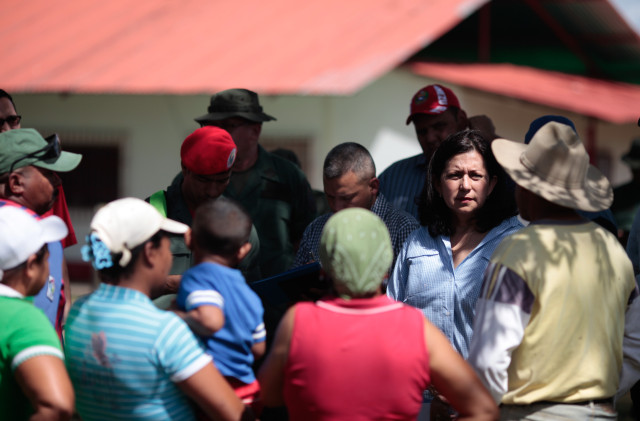
Minister Carmen Melendez meeting with the workers of Socialist Production Unit Of Joseph Cornelio Muñoz, in Apure state (Photo: The Venezuelan Presidential Press)
“The inclusion of women in the armed forces is a guarantor of peace….we are guarantors of peace: world peace, regional peace, and the peace of our own countries. Together, we are in this fight.”
When it comes to holding high-ranking, political positions of power, Carmen Teresa Meléndez is pretty much a pro. Serving for the presidencies of both Hugo Chavez and Nicolas Maduro, Minister Meléndez has worked not only as Minister of the Office of the President and Monitoring Management Government (her current title), but also as Minister of Defense and Minister of the Interior, Justice and Peace.
Meléndez refers to herself as the “‘Almiranta’ en Jefa,” (‘Admiral in Chief’), ‘almiranta’ being the made-up, female equivalent of the masculine, Spanish word “almirante”. This came as a result of her becoming Venezuela’s first female admiral after being named Minister of Defense under President Nicolas Maduro.
“I like ‘almiranta’, in the feminine form….they tell me it sounds strange, because before me there wasn’t this word,” Meléndez said. “But soon it will be normal. If a woman is going to be a pioneer, she must set the tone.”
2) Lucía Topolansky: Senator and Former First Lady, Uruguay

The press interviewing Senator Lucia Topolansky on the government’s pro-forest industry in Uruguay (Photo: Montecruz Foto via Flickr)
“If I look at the world and look at the very powerful women who have lived throughout the world, they are where they are because they fought, because they militarized, because they debated ideas. To me, then, that looks like one of our keys.”
She’s been referred to as “La Tronca” (‘The Tree Trunk”), a blonde-bombshell, an ex-guerilla, a jail-breaker, a bank-robber and an assassin. Even so, Senator Lucía Topolansky is also one of the most renowned political figures in Uruguay and Latin America.
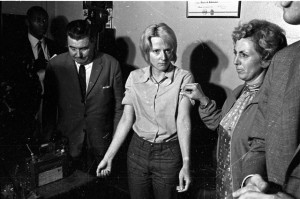
Center: A young Lucía Topolansky (Photo: GlobalPost)
While Topolansky loses a lot of the limelight to her simple-living husband, former president of Uruguay, Jose “Pepe” Mujica, the former first lady has a pretty noteworthy track record of her own. Back in 1969 as a member of the guerrilla group, the Tupamaros, Topolansky robbed the Monty Financial House. The banking institution was involved in a black market financial operation, leading Topolansky to spearhead a raid that left the bank short hundreds of thousands of dollars.
Her robbery days would land her behind bars for 13 years, but she still remained a rebel: she led two jailbreaks during her incarceration, including one in 1971 from Carcel de Cabildo, in which she helped free 38 revolutionaries. The vast majority of which — 36 — were women.
Today, the 69-year-old senator is a member of the upper-house in the Uruguayan government. In 2010, she served as Uruguay’s first ever, acting female president for a few days while her husband and the vice president were abroad.
3) Dilma Rousseff: President, Brazil
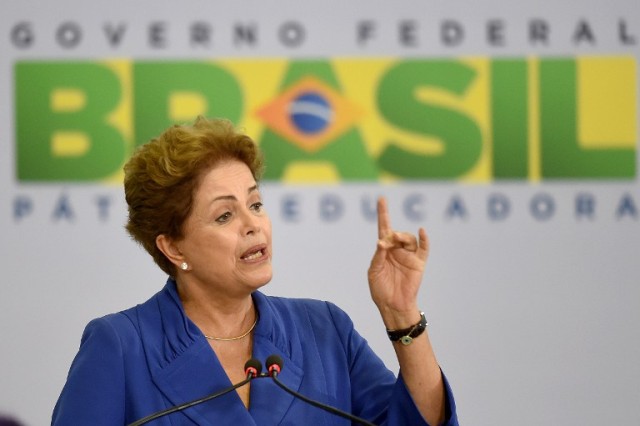
Brazilian President Dilma Rousseff delivers a speech during a ceremony to sanction a new zero-tolerance femicide law, at Planalto Palace in Brasilia, on March 9, 2015. (Photo: AFP/EVARISTO SA)
“I hope the fathers and mothers of little girls will look at them and say ‘yes, women can.'”

A 22-year-old Dilma Rousseff poses for a mugshot in São Paulo in 1970. (Photo: Wikipedia)
What can we say about Dilma Rousseff? Well for starters, as impressive as Topolansky’s background may be, she’s not Latin America’s only female revolutionary turned ‘jefa de gobierno’.
The same year Topolansky led a bank heist in Uruguay, Rousseff went underground as a member of the Marxist guerrilla group, VAR Palmares. As she became one of Brazil’s most wanted fugitives, she would be known as Luiza, Wanda, and Estela as a way to avoid being caught by authorities, and would be dubbed the “subversive Joan of Arc”.
Following her arrest in 1970, she was tortured for guerrilla secrets. Rousseff was released in 1972 but barred from any and all political activity. However, as the military left power and democracy restored in the 1980s, Rousseff was able to hold political office.
Over the last 30 years, Rousseff has held various government roles, including Brazil’s minister of energy, the chief of staff for the president, and finally, president of Brazil.
4) Cristina Fernández de Kirchner: President, Argentina
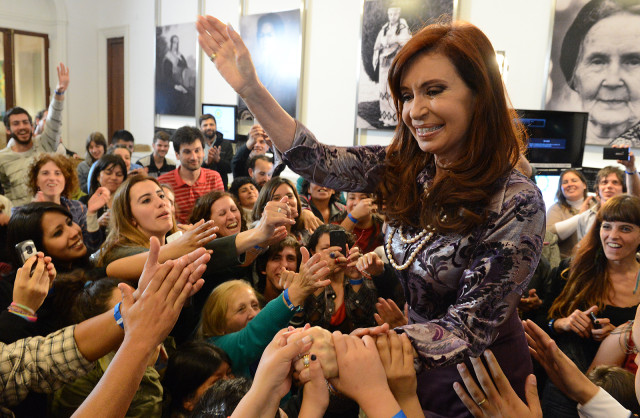
Cristina Fernandez de Kirchner , led a ceremony in which she gave financial support to the Popular Library “Palabras del Alma” . (Photo: The Ministry of Culture of Argentina)
“Our society needs women to be more numerous in decision-making positions and in entrepreneurial areas. We always have to pass a twofold test: first to prove that, though women, we are no idiots, and second, the test anybody has to pass.”
You may know of President Cristina Fernández de Kirchner as a result of a recent controversy surrounding the suspicious death of a prosecutor said to have had proof of a cover-up by the Argentine president in a 1994 bombing. While the allegations of a cover-up have been dismissed in court, the issue continues to taint Kirchner’s presidency.
Kirchner is a graduate of law school and started her political trek in the 1980s. She would first serve as a senator and then a deputy to the governor of Santa Cruz: her husband, Nestor Kirchner. She would eventually serve as first lady in 2003 when her husband was elected president.
In what would become known as the “Wives’ Duel” between herself and former first lady Hilda Gonzalez, Kirchner won the election for senator of Buenos Aires. She would later become president of Argentina, sparking comparisons to the famous Argentine first lady Eva Perón for her passion and popularity.
Cristina Fernandez de Kirchner is the first woman to be elected to the office of president in Argentina.
5) Michelle Bachelet: President, Chile
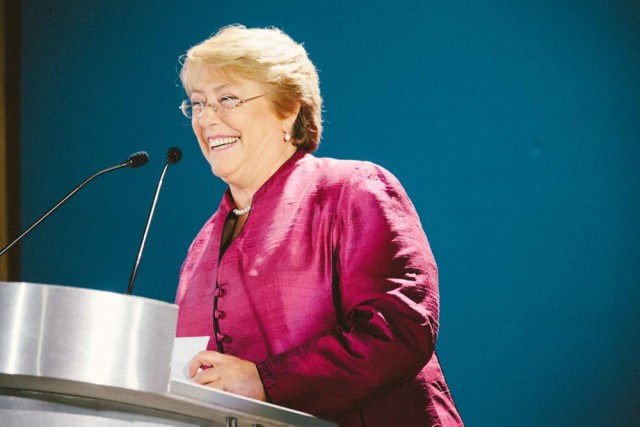
President Michelle Bachelet speaking during an event at El Centro Cívico de El Bosque 18. (Photo: Michelle Bachelet via Flickr)
“When women earn the money for the family, everyone in the family benefits. We also know that when women have an income, everyone wins because women dedicate 90 percent of the income to health, education, to food security, to the children, to the family, or to the community, so when women have an income, everybody wins.”
We conclude our profiles of ‘Las Jefas’ of Latin America with Michelle Bachelet, Chile’s two-term president. While she may exude positivity and flash smiles now, her youth was marked by political tragedy.
Bachelet’s father was a political prisoner who died while incarcerated for opposing the Pinochet government. In 1975, while Bachelet was in medical school, she and her mother were also imprisoned. They were tortured but eventually released into exile. Bachelet would not return to her native home of Chile until 1979.
Bachelet began her career in 1990, with the end of the Pinochet government. She served first as minister of health, then minister of national defense before winning the presidential election in 2006.
While in office, Bachelet has been a vocal supporter of both abortion and same-sex marriage rights.
Information for this article provided by AVN, Aporrea, GlobalPost, CNN, BBC News, and IB Times.
 CGTN America
CGTN America
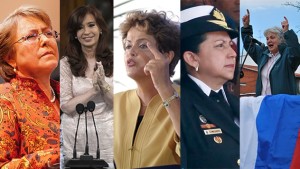 From (L) TO (R) : President Michelle Bachelet of Chile, President Cristina Fernández de Kirchner of Argentina, President Dilma Rousseff of Brazil, Carmen Meléndez, Venezuela’s First Female Minister of Defense, & Senator and former First Lady of Uruguay, Lucía Topolansky
From (L) TO (R) : President Michelle Bachelet of Chile, President Cristina Fernández de Kirchner of Argentina, President Dilma Rousseff of Brazil, Carmen Meléndez, Venezuela’s First Female Minister of Defense, & Senator and former First Lady of Uruguay, Lucía Topolansky
